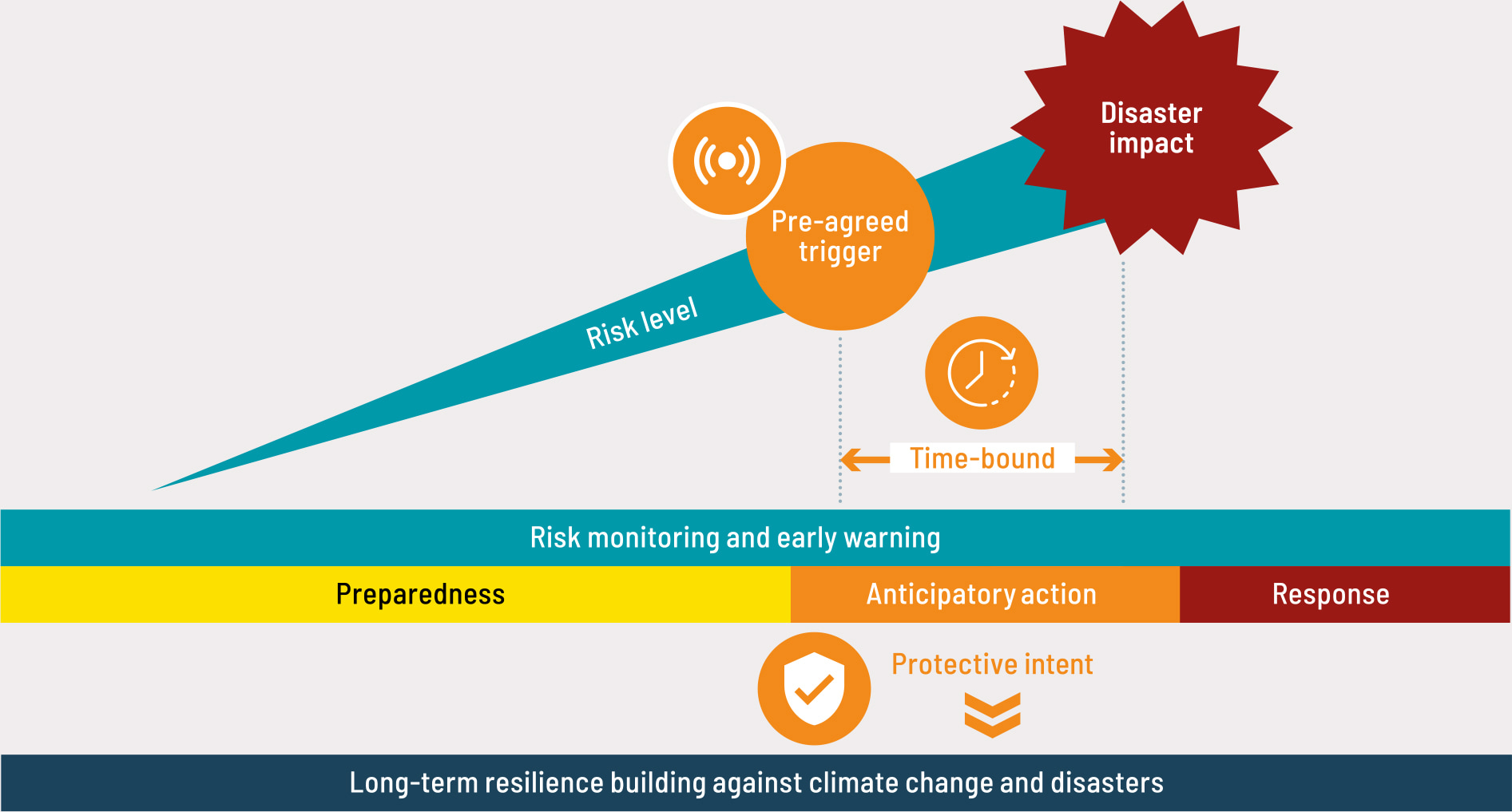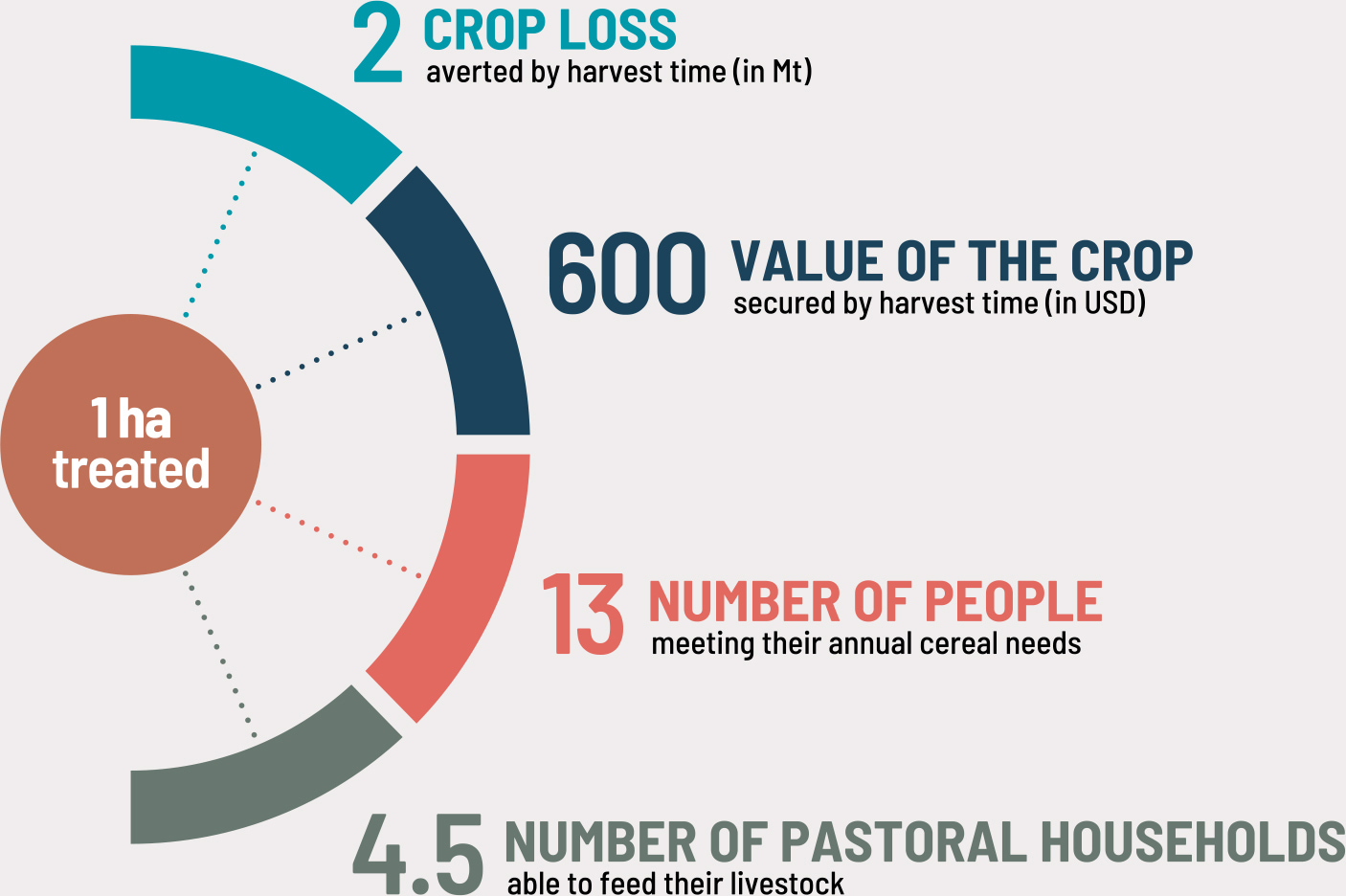4.3 Combining preventative control and anticipatory action – the case of desert locusts in the Horn of Africa
The desert locust upsurge that occurred in the greater Horn of Africa in 2020 and 2021 was among the worst such crises to strike the region ever recorded. It represented an unprecedented threat to food security and livelihoods, with the potential to cause widespread suffering, displacement and conflict. On that occasion, a set of risk-informed interventions that included preventative and anticipatory actions were undertaken to address the outbreak, which are deemed to have averted losses to a significant extent, especially in terms of cereals and livestock production. That experience is reported and analysed here, with a view to provide an example that can be scaled up in response to future outbreaks.
BOX 13 Methodology to estimate avoided losses from risk-informed desert locust intervention
Based on the experience of implementing the desert locust control operation upsurge in the greater Horn of Africa in 2020–2021, a new living methodology was developed to calculate the return on investment of FAO’s risk-informed intervention, using various considerations and assumptions.
Swarm and hopper bands consumption requirements per hectare are estimated considering the average density of swarms and bands. Reports from the field provided details about the nature of the control operation (air and ground) as well as the ratio of hoppers to swarms. Based on this information, every time one hectare is treated, there are around 30 tonnes of green matter and vegetation that is not consumed by desert locusts (protected). To assess the direct averted losses and impacts on productive livelihoods (farmers, agropastoralists and pastoralists), assumptions regarding the source of productive green matter and vegetation consumed by the desert locusts were formulated. Following these assumptions and some considerations derived from the literature, it is possible to calculate how much one hectare of desert locusts (hoppers and swarms) can destroy over their life cycle (i.e. reflecting mobility) in rangeland and farmland.
This reasoning allows estimating the crop loss averted by harvest time, the values of the crop secured, the number of people meeting their annual cereal needs and the number of pastoral households able to feed their livestock.
A more detailed description of the methodology to calculate avoided losses from risk-informed locust intervention can be found in Technical annex 5.
It should be noted that the Horn of Africa, where the 2020–2021 outbreak took place, is exposed to a variety of hazards. The risk-informed actions analysed in this section overlayed in parts of the region with flood, droughts, and conflict and/or insecurity, which also took a heavy toll in terms of economic losses. Together, these disasters – some linked to or exacerbated by the impacts of climate change – continue to deepen the exposure and vulnerabilities of people, systems and economies, and result in high levels of acute food insecurity across the region.as,243
In general, desert locust risk management requires a preventive control strategy based on monitoring of habitats of the involved species in key periods of their development. This allows early detection of increases in the number of insects and behavioural changes. In the Horn of Africa, the desert locust prevention and anticipatory action plan was launched on 24 January 2020, and extended until June 2022. The plan had two main objectives. First, scaling up surveillance and control, to reduce the impact on crop production and the rangeland carrying capacity. Second, anticipatory livelihood interventions were implemented based on the expectation that some outspread of desert locusts would still occur despite the monitoring operations. These interventions are deemed to have prevented households from reaching a condition of high food insecurity – corresponding to Phase 3+ of the International Phase Classification (IPC) – and consequently engaging in undesirable coping strategies, asset depletion and atypical movements with their livestock herds in search of pasture.
The timely and accurate early warning and forecasting information provided by FAO’s Desert Locust Information Service (DLIS) throughout the upsurge allowed the risk-informed strategies to be deployed. Under the L3at Locust Emergency, the DLIS collaborated with a wide team of professionals, which included academics along with research and private sector partners. This team generated 16 innovations that were integrated into the DLIS and the national locust programmes to further improve monitoring and early warning. In addition, drones were employed to survey the locusts in several countries with the support of the Desert Locust Regional Commissions in the central and western regions of the Horn of Africa. Efforts were complemented by ground surveillance teams of government officials, which played a critical role in accessing remote areas and providing early detection of locusts, especially during the so-called “hopper band stage”.au
As a result, 2.3 million ha of affected area was treated in the Horn of Africa and Yemen. It is estimated that for every hectare of desert locust infested land that is surveyed and controlled, an estimated 2 tonnes of grain are protected at an average value of USD 600. Pasture requirements for 4.5 tropical livestock units were also secured, as shown in FIGURE 44. The commercial value of the overall averted cereal and milk losses, after treating 2.3 million ha, was estimated at USD 1.77 billion. With this result and based on the methodology presented in Technical annex 5, at scale and risk-informed desert locust control interventions provide a return on investment of 1:15. This means that USD 1 invested in the intervention averted an estimated USD 15 of losses in the greater Horn of Africa.
FIGURE 43 KEY CHARACTERISTICS OF ANTICIPATORY ACTION

FIGURE 44 OUTCOME OF INTERVENTION PER HECTARE TREATED

From May 2020 to the end of 2021, through an investment of close to USD 90 million, FAO completed the delivery of livelihood packages reaching over 305 000 farming and livestock households (TABLE 7). Crop farmers received farming inputs and cash activities, while agropastoralists and pastoralists received feed and fodder inputs and cash.
TABLE 7 SUMMARY OF ACTIONS AND OUTCOMES FOR THE 2020–2021 DESERT LOCUST EMERGENCY

These collective efforts by FAO and partners averted 4.5 million tonnes of crop losses, saved 900 million litres of milk production, and secured food for nearly 42 million people. In addition, control in arid and semiarid lands have allowed pastoral and agropastoral households to enjoy adequate access to grazing areas for their ruminants. Converted into tropical livestock units and yearly milk productivity per tropical livestock unit, FAO estimates that the control intervention maintained over 3 million tropical livestock units. As with other anticipatory action mechanisms, the outcome analysis of interventions is expressed in terms of averted livelihoods impacts and losses.
It is worth recalling also that the upsurge in desert locusts was not the only disaster affecting the Horn of Africa in 2020–2021. Farmers in the Horn of Africa were already suffering from other disasters such as floods, droughts and storms, along with the COVID-19-related restrictions that limited access to agricultural inputs and decrease of planted areas (as presented in section 3.2.1).
The results show that without the preventative control of a desert locust upsurge, the maize and sorghum production in 2020 and 2021 might have been even lower. This has also called for a multihazard disaster risk reduction approach to ensure that the interventions implemented on the ground address the interconnected nature of disaster risks and their cascading impacts.
The overall lesson learned is that risk-informed action in the case of the locust upsurge has limited considerably the potential negative impact of the shock on agrifood systems and the associated livelihoods. It resulted in reduced damage to crops and rangelands, reduced pesticide sprays that have negative impacts on human health and the environment, and lowered financial costs. This approach facilitates a reduction in the occurrence and intensity of locust outbreaks and prevents them from developing into major upsurges or plagues. Over decades, this strategy has proven to be the most effective, making it possible to act before a significant increase in desert locust populations can occur. For such transboundary plant pests, this strategy also needs to be coupled with global or regional cooperation.
It should also be noted that continued support is required in the Horn of Africa to address future desert locust upsurges if countries are to count on a sustainable monitoring and control systems such as the one deployed in the 2020–2021 outbreak. Moreover, more frequent surveys lower the risk of unnoticed breeding. During years when conditions are not favourable to the breeding of locusts, such as drought years, it is still necessary to maintain the capacity of countries to prepare for the potential of a shock related to desert locusts, even in the face of competing priorities such as droughts and floods.
The risk of unnoticed breeding is particularly high in the areas of the region that cannot be surveilled due to security reasons, like most of Yemen and parts of Somalia. This calls for aggressive and wide-reaching campaigns against the desert locust. If pastoralists are not protected from hazards such as desert locusts or drought, these hazards will ravage rangelands and animals. Thus, steps should be taken to institutionalize ongoing surveillance and build measures to address future outbreaks, building on the success of the risk-informed action presented in this section on disaster risk reduction strategies, as well as plans in countries where there is high risk of desert locust outbreaks in the future.
